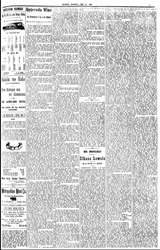Digital Collections
Celebrating the breadth and depth of Hawaiian knowledge. Amplifying Pacific voices of resiliency and hope. Recording the wisdom of past and present to help shape our future.
D. Kahaulelio
May 1902
LAWAIA KUIKUI A PAHOE ULUA. O ka lawaia kuikui ulua, aole ia i like me ka lawaia pahoe ulua, a e kamailio mua au ma ka mahele kuikui ulua, a pau ia hoike aku ka mahele pahoe ulua. Ma na kahakai papali, a kahakai aa nohoi, na wahi hana pinepine ia o keia ano lawaia. Ma na kahakai pali o Kahoolawe kahi i lawaia mau ai ko oukou mea kakau ma kahi ahiahi poeleele, ua hele pu au me koʻu makuakane i ka pakuikui ulua, a he puhi paka ka maua maunu, me kahi laau kaukau no hoi, a he aho olona kaakolu nuinui, hiki no hoi i kahi e lawaia ai, kukulu no hoi kahi laau kaukau a paa hoolei no hoi ka maunu, noke no hoi i ka pakuikui i ka puhi ma kahi kaheka kai no hoi e kupono ana i ka maunu, he uina ana o kahi laau, i paa aku ka hana pahua ka ikaika o ka makua a hiki i ke kohi ana i ka piko, aneane e lele pu i ke kai, o ka ulua liilii mai no puupa iuka, aka, ina he ulu[a] nunui, i kauia malino ke kaula e pono ai. Ma kuu lohe mai, o na mea Hanohano S. W. Kaai, me J. K. Iosepa, a me ka Mea Mahaloia C. R. Lindsey, Lunamakai o Lahaina, oiai lakou e noho ana i Hana, o lakou na pookela. Mokumoku hoi na manamana lima o na mea hanohano, a mai kauo pu ia hoi o C. R. Lindsey e ka ulua, o ka lakou hana mau ka ia i na po pouli malie maikai, aka, ma ka hai mai a Lindsey i ko oukou mea kakau, o na mea hanohano no ka lehua ma ka pakuikui ulua, a he laukea wale no ka ulua nui ma Hana e loaa ia lakou a he hapa ka ulua lauli. A o kekahi no hoi, he kiolaola maoli no. O ka mahele pahoe ulua, maloko a mawaho ia o kuanalu, e hoehoe ai, me ke kapapa no hoi o ka hoe i ka waa, aia no hoi ka maunu mahope e koelo ai me ka pula i mea e honi mai ai ka ulua i ka hauna a apo mai i ka maunu, i kahi manawa laki no, a he nele no i kahi wa, ua hana pinepine ia keia ma Lahaina nei i kahi wa, na Maihui (King) me Kalepa, aka, o Maihui no ka lehua ma keia ano lawaia, o kana mau koʻa no pahoehoe ulua mau ai, o Pakala no me Waiokama, mokumoku mau ke aho kaakolu o na halekuai, ina hoi e olelo ia aku e imi aku no hoi i koʻa okoa e pahoe ai, i mai la kela, i makemake no hoi au i kela mau koʻa, he laukea wale no ka ulua, hana io no paha kahi King, mai ka lawaia oio no a ka lawaia pahoe ulua. Ae, huki ka ulua la ea.
Kuʻikuʻi and Pāhoe Fishing for Ulua
Translated by Mrs. Mary Kawena Pukui
The Smithsonian Institution National Anthropological Archives: Mary Kawena Pukui collection #37 Fish and Fishing.
KUʻIKUʻI AND PĀHOE FISHING FOR ULUA. The kuʻikuʻi and the pāhoe fishing for ulua fish are not alike. First, let me describe the kuʻikuʻi method and after that is done the pāhoe. Along the hilly and rocky coast of Kahoʻolawe, your writer had often fished on dark nights. My father accompanied me when I went to do kuʻikuʻi fishing for ulua. We used a paka eel for bait and took a stout wooden pole with a thick, three ply olona cord. When we reached the place where we were to fish, the pole was set up and the bait tossed in. The eel was pounded up in a small sea pool large enough to contain the bait. The wooden pole creaked and when my father grasped it his strength was unequal to the task until he held the pole in the center at the same time leaning backward. He almost fell into the sea. A small ulua could be pulled ashore but a big one required a strong thick line. I have heard that the Hon. S. W. Kaai, J. K. Iosepa and the prominent Captain of Police C. R. Lindsey were the best fishers when they were in Hāna. The honorable gentlemen had their fingers cut by their lines and C. R. Lindsey was almost dragged into the sea by the ulua fish. They went fishing on every dark and calm night. According to what Lindsey told your writer the honorable gentlemen were greatly skilled in the pākuʻikuʻi fishing for ulua. The laukea variety of ulua were constantly caught by them in Hāna but not half as much of the lāuli variety. Some fished with regular pole and line. In the pahoe method, the fishing was done inside or outside of the reef. The canoe was rowed with the oars making no noise so that i moved noiselessly about. The bait trailed along behind with a bundle of mashed food to induce the ulua to take the bait when they smelled it. Sometimes there was luck and sometimes none at all. This was often done here in Lahaina by Maʻihuʻi (King) and Kalepa but Maʻihuʻi was the more skillful in this kind. His favorite pāhoehoe fishing grounds were Pakala and Waiokama. The three-ply cords bought in shops broke constantly and when he was told to try other fishing grounds to pāhoe in, he always replied that he preferred these becuase the ulua in them were of the laukea variety. He was a real worker when it came to ʻōʻio fishing and pāhoe fishing for ulua. Aye, the ulua were pulled in.

photo credit: www.nupepa.org